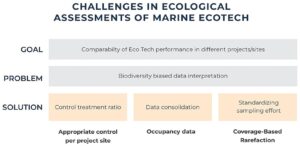In a recent peer-reviewed article published on Frontiers in Climate, ECOncrete’s marine biology team proposes a standardized, methodological assessment framework that represents biodiversity and other ecosystem services.
Why Standardized Assessments Are Essential
Integrating “greening the gray” ecosystem technologies (GTG EcoTech) within built marine environments, such as coastal and offshore infrastructure, represents a holistic approach that addresses ecosystem and operational services in parallel to essential engineering functions. However, the efficacy and long-term performance of GTG EcoTech remain subject to ongoing research. Despite the potential benefits, significant knowledge gaps persist regarding the ecological performance and assessments of greening the gray infrastructure that applies ecosystem technologies.

Figure 1: Challenges and solutions in ecological assessment of EcoTech applied to marine greening-the gray infrastructure
Achieving uniform biodiversity assessment methodologies where GTG EcoTech is utilized is essential for several reasons:
- Marine infrastructure varies widely
Marine infrastructure differs in size, location, and configuration (e.g., seawalls, breakwaters, piers, and offshore platforms). A biodiversity assessment framework makes it possible to collect consistent data from these different types of structures - Standardization enables comparisons across sites and conditions
Uniform methods facilitate comparisons across sites using varying sampling efforts and methodologies, and mitigate seasonal and geographical data differences. A consistent protocol helps determine whether observed biodiversity differences are due to: -
- The GTG EcoTech implementation,
- environmental changes, or
- discrepancies in how the data was collected or analyzed.
- It reduces the risk of greenwashing
As human activities increasingly alter natural habitats, understanding the efficiency of GTG EcoTech in marine infrastructure is essential to avoid “greenwashing” by ineffective strategies.
Methodological Approach for Comprehensive Monitoring of Biodiversity
The article emphasizes the importance of developing comparable biodiversity data collection and analysis methodologies, which are essential for assessing the effectiveness of various GTG EcoTech interventions. This will allow the quantification and comparison of GTG projects of various forms and locations, thus creating baseline development guidelines. Building on the Living Ports post-construction monitoring, it highlights the importance of:
- Establishing appropriate controls: Considering factors such as geographic proximity, habitat similarity, physical conditions (substrate orientation, light availability, oxygen levels, water movement, salinity, turbidity), and anthropogenic pressures (marine traffic, floating debris, run-offs, etc.). Controls should be selected under similar environmental conditions;
- Going beyond count and cover data to focus on occupancy: Using the occupancy approach promotes consistency in data collection across various contexts and facilitates easier comparisons over time or between locations;
- Standardized sampling effort / coverage-based rarefaction: Standardizing sampling effort through coverage-based rarefaction allows biodiversity comparisons that are not biased by uneven monitoring efforts.
An Imperative to Compare and Scale Greening The Gray Ecosystem Technologies
Establishing shared methodologies enables consistent data, supports meta-analyses, and strengthens the evidence base for nature-inclusive infrastructure. Common approaches also provide clarity for decision-makers, reduce the risk of greenwashing, and ensure transparent evaluation of ecological and social outcomes.
Standardized indicators for biodiversity, ecosystem services, and design performance can inform national and international “best practice” and support the integration of GTG monitoring frameworks into directives such as the EU Marine Strategy Framework Directive, the UN SDG 14, and the EU Nature Restoration Law.
A comparative approach allows ecologists, developers, and stakeholders to build a scalable understanding of ecosystem services across GTG projects, supporting informed decision-making and efficient resource management. Coordination across practitioners, organizations, and policymakers is essential to establish widely adopted data analysis protocols.
- Read the article: https://www.frontiersin.org/journals/climate/articles/10.3389/fclim.2025.1529019/full
- Living Ports Project: Measurable Biodiversity Gains in Marine Infrastructure: https://econcretetech.com/case-study/living-ports-project-measurable-biodiversity-gains-in-marine-infrastructure/
